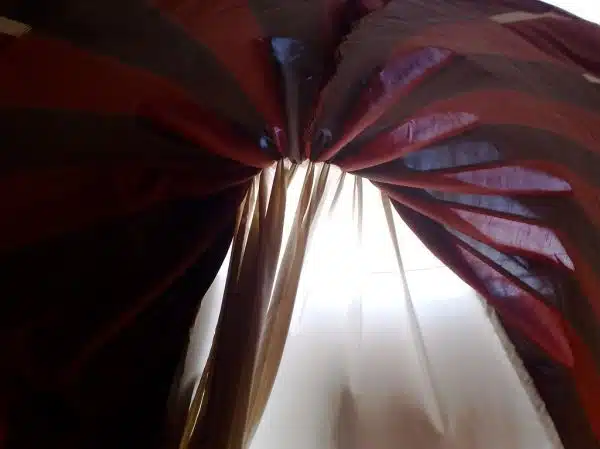As a professional house cleaner, I have encountered numerous households with dirty and dusty drapes or curtains. These window coverings not only gather dirt and dust but can also harbor bacteria and allergens, posing health risks to the inhabitants of the house. Therefore, it is essential to know how to clean drapes or curtains effectively.
In this article, we will discuss various methods of cleaning drapes or curtains depending on their fabric type and level of dirtiness. We will also explore some tips on how to maintain their cleanliness and prolong their lifespan. By following these guidelines, you can keep your home clean and healthy while also ensuring that your window coverings look as good as new.
Understanding The Importance Of Cleaning Drapes And Curtains
Maintaining a clean and healthy environment in your home is crucial for your family’s well-being. Cleaning drapes and curtains, which are often overlooked, can bring numerous benefits to your home. It not only improves the appearance of your windows but also enhances the indoor air quality by removing dust, allergens, and pollutants that accumulate on them over time.
The importance of cleaning drapes and curtains cannot be overstated. These window coverings act as a filter for dust, pollen, pet dander, and other airborne particles that enter your home. Over time, they accumulate on the fabric surface and can cause respiratory problems such as allergies or asthma. Regular cleaning of drapes and curtains helps to reduce these risks by removing these contaminants from your living space.
Cleaning drapes and curtains also prolongs their lifespan. Dust accumulation can cause discoloration or damage to the fabric if left unattended for too long. By removing dirt regularly, you prevent this buildup from causing permanent damage to the material. Additionally, clean window coverings add value to your home’s aesthetic appeal by giving it a fresh look and feel.
To ensure that you get the maximum benefits from cleaning your drapes or curtains, it is important to identify the fabric type first before starting any cleaning process. This will enable you to choose an appropriate cleaning method suitable for each cloth type without damaging them along with ensuring longevity of their use in good condition..
Identifying The Fabric Type Of Your Window Coverings
Before cleaning your drapes or curtains, it is essential to identify their fabric type. Differentiating between natural and synthetic fabrics is crucial in determining the best cleaning method for your window coverings.
Natural fabrics, such as cotton, silk, and linen, require gentle cleaning methods. They are prone to shrinking or discoloration when exposed to harsh chemicals. On the other hand, synthetic fabrics like polyester and nylon are more durable and can withstand stronger cleaning agents.
To determine the fabric type of your curtains or drapes, check for any labels attached to them. The label should indicate whether they are made from natural or synthetic materials. If there is no label present, you can perform a simple burn test by cutting a small piece of fabric and burning it with a lighter. Natural fibers will burn slowly and produce ash while synthetic fibers will melt and form hard beads.
Determining the best cleaning method based on fabric type is crucial in preserving the quality of your window coverings. Once you have identified the material used in your drapes or curtains, you can proceed with choosing an appropriate cleaning method that will not damage the fabric. In the next section, we will discuss how to check for any special cleaning instructions that may be present on your window coverings.
Checking For Any Special Cleaning Instructions
- Before cleaning drapes or curtains, it is important to check the fabric label for any special cleaning instructions.
- It is also advisable to spot-test any cleaner that is being used on the fabric, to ensure that it is safe to use.
- Care should be taken when cleaning delicate fabrics, as improper cleaning techniques may cause damage.
- If in doubt, professional house cleaners should be consulted for the best advice on how to clean drapes or curtains safely.
Checking Fabric Label
As a professional house cleaner, understanding fabric labels is crucial in ensuring that drapes or curtains are cleaned properly. Checking the fabric label before cleaning can save you from damaging the fabric or causing any discoloration. Different fabrics require specific cleaning methods, and it’s important to be aware of any special cleaning instructions.
The fabric label usually provides information on how to clean the material, including washing instructions, water temperature recommendations, and whether it can be ironed or dry-cleaned. If there are no specific instructions provided on the label, you can refer to Fabric Cleaning FAQs for guidance. Some fabrics may require hand washing while others may be machine washable on a gentle cycle.
It’s also important to note that some materials may shrink or lose color if exposed to certain chemicals or high temperatures. Understanding the fabric label will help you determine whether it’s safe to use bleach or other harsh chemicals. Always take extra care when handling delicate fabrics such as silk or velvet, as they require gentle handling during cleaning. By checking the fabric label and following any special cleaning instructions provided, you can ensure that your drapes or curtains look their best without causing any damage in the process.
Spot-Testing Cleaner
When it comes to cleaning drapes or curtains, checking the fabric label for any special cleaning instructions is crucial. However, even if a specific cleaning method is recommended, it’s still important to spot-test any cleaner before using it on the entire surface. Spot-testing helps ensure that the product you’re using won’t damage or discolor the fabric.
To test the effectiveness of a cleaner, apply a small amount to an inconspicuous area of the fabric and wait for a few minutes. Then, gently blot the spot with a clean cloth and check for any discoloration or damage. If there are no adverse effects, you can proceed with cleaning the rest of the surface.
Choosing the right products is also important when spot-testing cleaners. Avoid using bleach or harsh chemicals on delicate fabrics such as silk or velvet. Instead, opt for mild detergents or specialized fabric cleaners that are designed specifically for those materials. By taking these precautions and spot-testing any cleaner before use, you can safely and effectively clean your drapes or curtains without damaging them in the process.
Preparing Your Cleaning Materials
After checking for any special cleaning instructions, it is time to gather the appropriate cleaning materials. One of the most important aspects of cleaning drapes or curtains is choosing the right cleaning solutions. It is essential to know what type of fabric your drapes or curtains are made of and choose a solution that is safe for that particular fabric.
For example, if your drapes or curtains are made of delicate silk, you do not want to use a harsh detergent that could damage the fabric. Instead, opt for a gentle solution like woolite or a mixture of warm water and vinegar. On the other hand, if your drapes or curtains are made of cotton, you can use a more robust solution like laundry detergent mixed with warm water.
Organizing your cleaning space is also crucial in ensuring an effective cleaning process. Before beginning, ensure that you have all the necessary materials within reach. This includes your chosen cleaning solutions, a bucket filled with warm water, clean cloths or sponges for wiping down surfaces, and a vacuum cleaner with an appropriate attachment for upholstery.
By taking these steps to carefully choose appropriate cleaning solutions and organizing your cleaning space beforehand, you will be setting yourself up for success in achieving sparkling clean drapes or curtains. In the next section, we will explore another essential step in this process – the vacuuming method.
The Vacuuming Method
Vacuuming curtains is a great way to keep them clean and free of dust. It’s important to vacuum your curtains regularly, especially if you have allergies or breathing difficulties. Dust can accumulate on curtains over time, which can cause respiratory problems for those who are sensitive to it.
When vacuuming curtains, start by removing any loose dirt or debris with a soft-bristled brush. Then, attach the upholstery attachment to your vacuum cleaner and use it to gently clean the surface of the curtains. Be sure to move the attachment in a straight line from top to bottom, rather than using a circular motion, as this can damage the fabric.
Dusting drapes is another effective way to keep them clean. You can use a soft-bristled brush or a lint roller to remove any dust or debris that has accumulated on the surface. Be sure to work from top to bottom and take care not to snag the fabric as you go. Regular dusting will help prevent dirt from building up on your drapes and prolong their lifespan.
Transition: While vacuuming and dusting are effective methods for cleaning curtains and drapes, sometimes hand-washing may be necessary for more stubborn stains or odors. In the next section, we will explore the hand-washing method in more detail.
The Hand-Washing Method
- To begin the hand-washing process, it is important to gather supplies including a mild detergent, a bucket, and a soft brush.
- Before cleaning, the drapes need to be laid out and examined for any stains or spots that require pre-treatment.
- After pre-treatment, the drapes should be submerged in a bucket of warm water mixed with a mild detergent.
- Gently scrubbing the drapes with a soft brush will help to remove any remaining dirt or dust.
- Afterwards, the drapes should be rinsed with clean water and hung to dry.
- Finally, the drapes should be ironed to ensure a clean and crisp look.
Gather Supplies
When it comes to cleaning drapes or curtains, the first step is to gather all the necessary supplies. It’s important to have everything on hand before starting the cleaning process to avoid any interruptions or delays. Cleaning supplies such as a vacuum cleaner with a hose attachment, a soft-bristled brush, and a gentle laundry detergent are essential.
When selecting cleaning supplies, it’s important to choose products that are safe for your specific type of fabric. Take note of any special care instructions that may be listed on your curtains’ label or tag. If you’re unsure about what products to use or where to buy them, do some research online or consult with a professional cleaner.
Fortunately, most cleaning supplies can be easily found at your local grocery store or home goods store. Some popular retailers that carry these items include Walmart, Target, and Amazon. Additionally, specialty stores such as Bed Bath & Beyond and The Container Store may offer more specialized cleaning tools and solutions for curtains and other household items. With the right supplies in hand, you’ll be well-prepared to tackle even the toughest curtain cleaning challenges!
Prepare Drapes
To ensure that your drapes are cleaned thoroughly, it’s important to prepare them properly before washing. Measuring your windows accurately is the first step in this process, as it will help you determine the size of the cleaning space you’ll need. Once you’ve done this, it’s time to choose a style that suits your needs and preferences.
When preparing your drapes for hand washing, start by removing any hardware or accessories such as hooks or rings. This will prevent these items from getting tangled up during the washing process and potentially damaging the fabric. Next, gently shake out your drapes to remove any loose dirt or debris. This can be done outdoors or in a well-ventilated area to avoid spreading dust and allergens around your home.
Finally, fill a clean bathtub with lukewarm water and add a gentle detergent that is safe for your specific type of fabric. Place your drapes into the water one at a time, gently agitating them to ensure that they are fully immersed in the soapy solution. Allow them to soak for 15-20 minutes before carefully draining the tub and rinsing each drape thoroughly with cool water. With these simple preparation steps, you’ll be well on your way to achieving clean and fresh-looking drapes!
Wash Drapes
When it comes to cleaning drapes, it’s important to understand the type of fabric you’re dealing with. Different fabrics require different cleaning methods in order to maintain their quality and appearance. Before beginning the hand-washing process, make sure you know what type of fabric your drapes are made of, and choose a cleaning method that is appropriate for that particular material.
The hand-washing method is a great option for those who want to take extra care when cleaning their drapes. This method involves removing any hardware or accessories from the drapes before gently shaking them out to remove loose dirt and debris. Once this preparation is complete, you can fill up a bathtub with lukewarm water and add a gentle detergent that is safe for your specific type of fabric. From there, it’s simply a matter of soaking the drapes in the soapy solution before rinsing them thoroughly with cool water.
Choosing the right cleaning method for your drapes can be challenging, but with a little bit of knowledge and preparation, you can achieve great results. Whether you’re dealing with delicate silk or sturdy cotton, understanding fabric types is key in determining how best to clean your drapes. By using the hand-washing method and following these simple steps, you can ensure that your drapes look clean and fresh for years to come.
The Machine-Washing Method
The Machine-Washing Method is a popular way to clean drapes or curtains. One of the benefits of machine washing is that it’s convenient and time-saving, especially for those who have busy schedules. The process involves putting the drapes in the washing machine with detergent and running a gentle cycle.
However, there are also drawbacks to this method. Machine washing can be harsh on delicate fabrics and can cause shrinkage or damage to embellishments such as tassels or embroidery. It’s important to check the care label on the drapes before attempting this method. If they require dry cleaning only, do not attempt to machine wash them.
Overall, the Machine-Washing Method is an effective way to clean most types of drapes or curtains but should be approached with caution. Always follow the care instructions on the label and take note of any potential risks that may come with washing your particular set of drapes. If in doubt, it’s best to seek professional advice from a cleaning service before proceeding with any cleaning method.
Moving forward, if you are hesitant about using the Machine-Washing Method due to its drawbacks, there is another alternative: The Dry Cleaning Method. This method involves taking your drapes to a professional cleaner who will use specialized equipment and techniques that are gentle on delicate fabrics and embellishments. Read on for more information about this method and how it can benefit your drapes or curtains in the long run.
The Dry Cleaning Method
- Before beginning the dry cleaning process, it is important to check the fabric content of the drapes or curtains to ensure they are safe for dry cleaning.
- Dry cleaning is a safe and effective way to clean drapes and curtains, and is typically the preferred method for delicate items.
- During the dry cleaning process, the drapes or curtains will be gently washed and dried, and any necessary restorations or repairs may also be completed.
- After the dry cleaning is complete, it is important to hang the items in a dry, well-ventilated area to prevent any mold or mildew from forming.
- Regular maintenance and cleaning of drapes or curtains is important to keep them looking their best, and dry cleaning should be done on an as-needed basis.
- If spills occur, it is important to spot-clean the affected area immediately and if necessary, dry clean the entire item to prevent any further damage.
Preparing For Dry Cleaning
Preparing for dry cleaning can be a straightforward process if you know what to do. Before starting, make sure that your drapes or curtains are labeled with any special instructions for cleaning or maintenance. This will help prevent any damage that may occur during the cleaning process.
Choosing a reliable and professional dry cleaning service is essential. Make sure to research different companies and read reviews from previous customers before making a decision. You should also ask about their experience with cleaning drapes or curtains, as well as what kind of equipment they use.
When preparing your drapes or curtains for dry cleaning, remove any hooks, rings, or other hardware that may damage the fabric during the cleaning process. It’s also recommended to dust them off with a soft brush or vacuum cleaner to remove any loose dirt or debris before sending them off to the cleaners. By following these simple steps, you can ensure that your drapes and curtains are properly prepared for dry cleaning and will come back looking good as new.
What To Expect From Dry Cleaning
When it comes to dry cleaning, it’s important to understand what to expect from the process. One of the main benefits of using this method is that it can help extend the life of your drapes or curtains by removing dirt and stains that may not be easily removed with DIY cleaning methods. Additionally, dry cleaning alternatives such as wet-cleaning or hand-washing may not be suitable for certain fabrics or styles.
Before sending your drapes or curtains off for dry cleaning, it’s important to understand that some shrinkage may occur due to the heat and pressure used during the process. However, a professional dry cleaner will take steps to minimize this risk and ensure that your items are returned in good condition. You should also expect any stains or discoloration to be significantly improved, if not completely removed.
After your drapes or curtains have been dry cleaned, they will typically be pressed and hung on hangers for transport back to your home. It’s important to inspect them carefully before hanging them back up in order to ensure that any hooks or hardware have been reattached properly and that there are no lingering stains or damage. Overall, by understanding what to expect from dry cleaning and choosing a reputable service provider, you can help keep your home looking its best for years to come.
Aftercare For Dry Cleaned Drapes
Now that we’ve discussed the benefits of dry cleaning and what to expect during the process, it’s important to also consider the aftercare for your freshly cleaned drapes. Proper storage is crucial in maintaining their appearance and prolonging their lifespan. One tip for storage is to keep them out of direct sunlight and away from moisture or damp areas. It’s also recommended to use garment bags or covers to protect them from dust and dirt.
In terms of how often you should clean your drapes, it depends on various factors such as the material, location, and usage. However, a general rule of thumb is to have them professionally dry cleaned every one to two years. For those who live in areas with heavy pollution or have pets, more frequent cleanings may be necessary. Regular vacuuming can also help remove surface dirt and prevent buildup.
Lastly, when hanging your freshly cleaned drapes back up, make sure they are properly aligned and adjusted for any shrinkage that may have occurred during the dry cleaning process. Avoid pulling or tugging on them too much as this can cause damage or strain on the fabric. By following these tips for aftercare, you can ensure that your drapes look their best for years to come.
The Steaming Method
The Dry Cleaning Method is a popular way to clean drapes and curtains. However, it can be expensive and time-consuming. In comparison, the Steaming Method offers several benefits that make it an attractive alternative.
One benefit of steaming is that it is a more eco-friendly option than dry cleaning. The process uses only water and heat, which means there are no harsh chemicals involved. Additionally, steaming can help remove allergens and dust mites from your drapes or curtains. This is especially important for those with allergies or respiratory issues.
Another advantage of steaming is its ability to remove wrinkles and freshen up fabric. Unlike dry cleaning, which can leave fabrics feeling stiff and unnatural, steaming maintains the softness and texture of the material. Plus, it is less likely to cause shrinkage or damage to delicate fabrics like silk or lace.
When compared with other cleaning methods like washing or spot cleaning, steaming is also faster and easier. It doesn’t require any scrubbing or soaking – simply run the steamer over the fabric to remove dirt or stains. Overall, using a steam cleaner for your drapes or curtains provides a gentle yet effective way to keep them looking fresh and clean.
Looking for tips on how to remove stains and odors from your drapes? Stay tuned for our next section where we will go over some helpful techniques!
Tips For Removing Stains And Odors
Stains can be removed from curtains or drapes by pre-treating the stain with a liquid detergent, then washing in the washing machine with a mild detergent. Odor removal can be accomplished by adding a cup of white vinegar or two tablespoons of baking soda to the wash cycle. Natural cleaners such as lemon or vinegar can be used on light stains or odors, or combined with other natural cleaners like baking soda to tackle tougher stains. For more stubborn stains, a commercial laundry-spot remover can be used in combination with a mild detergent. For odors that persist after washing, a fabric refresher can be used to deodorize the material. Finally, it is important to air dry the curtains in order to prevent further stains and odors from setting in.
Stain Removal
Removing stubborn stains from drapes or curtains can be challenging, but with the right techniques and products, you can effectively eliminate them. The first step is to identify the type of stain and its source, as this will determine the most appropriate cleaning method. For example, grease stains can be treated with baking soda or cornstarch, while blood stains require cold water and hydrogen peroxide.
Natural cleaning methods are a safe and effective way to remove stains from drapes or curtains without using harsh chemicals that could damage them. One such method involves mixing equal parts of vinegar and water in a spray bottle and applying it directly onto the stained area. Let it sit for several minutes before blotting it with a clean cloth. Alternatively, you can use lemon juice or salt to treat stubborn stains.
It’s essential to always test any cleaning solution on an inconspicuous area of your drape or curtain before using it on the entire fabric to avoid any damage or discoloration. With persistence and the right tools at your disposal, removing tough stains from your drapes or curtains becomes much easier. By using natural cleaning methods, you can achieve excellent results while maintaining the quality of your fabrics for years to come.
Odor Removal
Removing stains from drapes or curtains is not the only cleaning challenge that homeowners face. Odor removal is also an essential task in maintaining the cleanliness of your home. Foul smells can come from various sources, including mildew, pet urine, and cigarette smoke. Removing odors requires a different approach than removing stains, but with proper techniques and products, you can eliminate even the most stubborn smells.
Dealing with mildew is one of the most common odor problems that homeowners encounter. Mildew thrives in humid environments and can cause a musty smell that lingers on fabrics like drapes or curtains. To remove mildew odor, start by vacuuming away any visible spores from the fabric’s surface. Next, mix equal parts of water and white vinegar in a spray bottle and apply it to the affected area. Allow it to sit for 10-15 minutes before rinsing it off with clean water.
For pet urine or cigarette smoke odors, baking soda is an effective natural deodorizer. Sprinkle baking soda generously onto the fabric’s surface, making sure to cover all areas evenly. Let it sit for several hours or overnight before vacuuming it away. If the odor persists despite using baking soda, consider using an enzymatic cleaner specially formulated for pet urine or a commercial smoke odor eliminator product.
In conclusion, removing odors from drapes or curtains requires a different approach than removing stains. Dealing with mildew involves using white vinegar while baking soda is an effective natural deodorizer for pet urine or cigarette smoke odors. By following these tips and techniques, you can maintain fresh-smelling fabrics in your home without relying on harsh chemicals that could damage them over time.
Natural Cleaners
As a professional house cleaner, one of the most important tasks is to remove stains and odors from fabrics like drapes or curtains. While there are various commercial products available for this purpose, some homeowners prefer DIY natural cleaners that are eco-friendly alternatives. Natural cleaners are effective in removing stains and odors without using harsh chemicals that could harm the environment or the fabric’s quality.
One of the most popular DIY natural cleaners is white vinegar. It can be used to remove stains, mildew, and odor from fabrics. To use white vinegar as a cleaner, mix equal parts of water and vinegar in a spray bottle and apply it to the affected area. Let it sit for 10-15 minutes before rinsing it with clean water. White vinegar not only removes stains but also disinfects the fabric by killing bacteria and germs.
Another natural cleaner that is effective in removing stains and odor is baking soda. Baking soda works by absorbing moisture and neutralizing odors. To use baking soda as a cleaner, sprinkle it onto the fabric’s surface generously and let it sit for several hours or overnight before vacuuming it away. Baking soda is safe to use on all types of fabrics, including delicate ones like silk or lace.
In summary, DIY natural cleaners are eco-friendly alternatives that can effectively remove stains and odors from fabrics like drapes or curtains. White vinegar is an excellent cleaner for mildew while baking soda is an effective deodorizer for pet urine or cigarette smoke odors. By using natural cleaners instead of harsh chemicals, homeowners can maintain fresh-smelling fabrics without harming their health or the environment.
Tips For Maintaining Cleanliness
As a professional house cleaner, maintaining cleanliness is a top priority. Dust and stains on drapes or curtains can be unsightly and can even affect the air quality inside your home. To keep your window coverings looking fresh and clean, here are some tips for preventing dust and stains from accumulating:
Firstly, vacuum your drapes or curtains regularly to remove any surface dust. Use a soft brush attachment to prevent damage to the fabric. Secondly, avoid placing any objects near the window that could cause staining or discolouration, such as potted plants or humidifiers. Lastly, consider using blackout liners or shades to protect against sunlight damage.
When it comes to cleaning solutions for different types of window coverings, it’s best to follow manufacturer instructions. For example, velvet drapes may require dry cleaning only, while cotton curtains can be laundered in a washing machine with mild detergent. Always test any cleaning solution on an inconspicuous area before applying it to the entire drape or curtain.
By following these tips for preventing dust and stains on your drapes or curtains and using appropriate cleaning solutions, you can ensure that they remain in good condition for years to come. In the next section, we will discuss tips for prolonging the lifespan of your window coverings without compromising their appearance or functionality.
Tips For Prolonging The Lifespan Of Your Drapes And Curtains
Regular Cleaning is essential to prolonging the lifespan of drapes and curtains. Dust, dirt, and other debris can accumulate on the fabric and cause it to fade and deteriorate. Vacuuming is usually the best way to clean them, but avoid using a brush attachment as this can damage delicate fabrics. Proper Storage can help protect drapes and curtains from dust and dirt accumulation, as well as fading from sunlight. To preserve the fabric, store drapes and curtains in a cool, dry place away from direct sunlight exposure. Sun Protection is also important in prolonging the lifespan of drapes and curtains. A good way to protect them from the sun is by using window treatments such as blinds or shades to block out direct sunlight. Additionally, fabrics with a protective coating are available and can be used to provide extra protection from the sun’s UV rays.
Regular Cleaning
Maintaining the cleanliness of your drapes and curtains is crucial for the longevity of their lifespan. The frequency of cleaning your window treatments will depend on various factors such as the type of fabric, location, and environmental elements. Regardless, it’s important to establish a regular cleaning routine to prevent dust buildup, stains, and odors from settling in. Neglecting this task can lead to irreversible damage that may require costly repairs or replacements.
When it comes to cleaning drapes and curtains, choosing the right products is essential. Using harsh chemicals or abrasive cleaners can cause discoloration, shrinkage, or damage to the fabric. Instead, opt for gentle yet effective solutions that are specifically designed for window treatments. Some of the best cleaning products include steamers, vacuum attachments with soft bristles, and dry-cleaning kits. These options will help remove dirt and grime without causing harm to the material.
In conclusion, investing time in regular cleaning will help prolong the lifespan of your drapes and curtains significantly. By prioritizing this task and using the best cleaning products available like steamers or vacuum attachments with soft bristles, you can ensure that your window treatments remain in pristine condition for years to come. Remember that prevention is always better than cure when it comes to home maintenance!
Proper Storage
Proper storage is an essential part of maintaining the longevity of your drapes and curtains. It’s crucial to store them correctly to prevent wrinkles, damage, and dust buildup. Before storing, ensure that your window treatments are clean and dry by following the appropriate cleaning methods. Once the cleaning process is complete, you can move on to proper storage.
One way to store your drapes and curtains is by using hangers. This method helps maintain their shape and prevents wrinkles from settling in. Ensure that you choose hangers that are appropriately sized for your window treatments and avoid overcrowding them on a single hanger. Another option is to fold them carefully and place them in a storage box or container. Avoid stuffing them into a container as this may cause creases and wrinkles.
Lastly, it’s important to store your drapes and curtains in a cool, dry place away from direct sunlight or moisture. Sunlight can cause fading or discoloration of the fabric, while moisture can lead to mold growth or mildew buildup. When storing in a container or box, label it appropriately with the type of fabric or color to make it easier for you when redecorating. With proper storage techniques like these, you can help prolong the lifespan of your drapes and curtains significantly!
Sun Protection
Proper storage is just one aspect of taking care of your drapes and curtains. Another essential factor that you should consider is sun protection. While sunlight can bring several benefits, it can also damage your window treatments over time.
The sun’s UV rays can cause fading, discoloration, and weakening of the fabric fibers, which can lead to tears or holes in your curtains. To prevent this from happening, you should consider using sun protection methods like UV blocking films or blinds to protect your drapes and curtains from direct sunlight. These alternatives are effective in reducing the amount of light that enters your room while still allowing natural light to filter through.
In addition to using sun protection methods, another way to protect your window treatments is by rotating them regularly. This technique ensures that each side of the fabric receives equal exposure to sunlight, preventing uneven fading and prolonging their lifespan. With proper care and attention, you can ensure that your drapes and curtains continue to enhance the ambiance of your home for a long time!
Common Mistakes To Avoid When Cleaning Drapes And Curtains
When it comes to cleaning drapes and curtains, there are common mistakes that homeowners make that can cause damage or result in ineffective cleaning. One of the most common mistakes is not checking the care instructions on the label before cleaning. This can lead to using the wrong cleaning method or products, causing discoloration or shrinkage.
Another common mistake is using too much water when cleaning. While water is necessary for effective cleaning, excessive water can saturate the fabric and cause mold or mildew growth. It’s important to use a gentle detergent and follow the recommended amount of water for your specific type of drapes or curtains.
Lastly, not properly drying the drapes or curtains can result in wrinkles or shrinkage. It’s important to follow the care instructions for drying, whether it’s air-drying or machine-drying on low heat. Hanging them back up while still damp can also lead to mold growth.
To help you avoid making these mistakes, we have compiled a table of effective techniques for cleaning specific types of drapes and curtains:
| Type of Fabric | Effective Technique |
|---|---|
| Cotton | Machine-wash on gentle cycle with cold water; hang dry |
| Silk | Dry clean only |
| Velvet | Spot-clean with a mixture of warm water and mild detergent; air dry |
| Sheer | Hand-wash with a gentle detergent in cold water; hang dry |
| Linen | Machine-wash on delicate cycle with warm water; tumble dry on low heat |
By following these effective techniques and avoiding common mistakes, you can successfully clean your drapes and curtains without causing damage. However, if you’re unsure about how to properly clean your specific type of fabric or if you simply don’t have the time or resources to do so yourself, it may be time to seek professional cleaning services.
When To Seek Professional Cleaning Services
One of the most common misconceptions about cleaning drapes and curtains is that DIY methods are always the best option. While these methods can be effective for removing surface-level dirt and dust, they often fall short in terms of thoroughness. This can lead to a buildup of allergens, bacteria, and other harmful substances over time. In contrast, professional cleaning services offer numerous benefits that make them a cost-effective alternative.
One major benefit of professional cleaning services is their ability to remove deep-seated dirt and grime from drapes and curtains. This is done through the use of specialized equipment and techniques that go beyond what is achievable through DIY methods alone. Additionally, professional cleaners are trained to identify potential issues such as fading or fabric damage before they become major problems.
Another key advantage of professional cleaning services is their cost-effectiveness over time. While it may seem cheaper to clean drapes and curtains yourself, this approach can actually end up costing more in the long run due to potential damage or inadequate cleaning techniques. By investing in professional cleaning services instead, you can ensure that your drapes and curtains last longer while also enjoying improved indoor air quality.
Overall, while DIY cleaning methods may seem like the simpler option at first glance, the cost effectiveness of professional cleaning services for drapes and curtains makes them a smart investment for any homeowner or renter looking to maintain a healthy living environment.
Final Thoughts On Cleaning Drapes And Curtains
Once you have finished cleaning your drapes or curtains, it is important to properly store them to maintain their cleanliness. Here are some tips for storage:
- Fold them neatly and avoid crushing them to prevent deep wrinkles.
- Store them in a dry place away from direct sunlight to prevent fading.
- Use garment bags or plastic covers with ventilation holes to protect the fabric from dust and insects.
Choosing the right cleaning products is crucial when it comes to cleaning your drapes or curtains. Always check the label for instructions and follow them carefully. Here are some general tips:
- Avoid using bleach or harsh chemicals that can damage the fabric.
- Use a gentle detergent that is suitable for the fabric type.
- Test any new cleaning product on a small, inconspicuous area first before applying it to the entire drape or curtain.
In summary, maintaining clean drapes or curtains requires proper storage and choosing the right cleaning products. By following these tips, you can keep your home looking fresh and tidy for years to come.
Table Example:
| Tips for Storage | Choosing the Right Cleaning Products |
|---|---|
| Fold neatly | Avoid harsh chemicals |
| Keep dry | Use gentle detergent |
| Use garment bags | Test new products on small area first |
| Store away from sunlight |
Note: The second column only has three bullet points as one of the rows was left blank intentionally for visual balance purposes.
Conclusion
Cleaning drapes and curtains is essential for maintaining the beauty and hygiene of your home. It’s important to identify the type of fabric your window coverings are made of before cleaning them. Check for any special cleaning instructions to ensure you don’t damage the material. Preparing your cleaning materials is also crucial to make sure you have everything on hand.
The vacuuming method is an effective way to clean most drapes and curtains, but be sure to follow the specific instructions for each type of fabric. Avoid common mistakes such as using hot water or harsh chemicals that may cause discoloration or shrinkage. If you’re unsure about how to clean your window coverings, it’s best to seek professional cleaning services.
In conclusion, taking care of your drapes and curtains can help prolong their lifespan and keep them looking new for years to come. As professional house cleaners, we understand the importance of maintaining a clean and hygienic living environment for our clients. By following these tips, we hope you can enjoy fresh, beautiful window coverings in your home. Remember that even small details like clean drapes and curtains can make a big impact on the overall look and feel of your space.
Image Credits
- “Curtain upskirt” by Unlisted Sightings (featured)





























